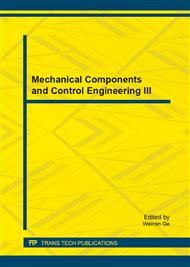p.64
p.70
p.74
p.79
p.83
p.87
p.91
p.95
p.102
The Analysis for Crystallization of Sn-Pb Alloys Using Acoustic Emission Testing about Wind Turbine Root Materials
Abstract:
Regular researches of system Sn-Pb alloys with use AE are carried out in various crystallization conditions. In the given researches the technique has been used, which allow to divide the signals radiated with plastic deformation and crack's formation and development from each process. In the metals and alloys majority radiation of AE signals begins in the middle of crystallization's area and comes to an end at the moment of the crystallization termination However in a number of materials AE signals have been registered below an excess point on a cooling curve in a firm condition. Essential influence of small impurity on AE feature and is revealed at crystallization AE character with crystallization of pure metals is defined by a kind of a crystal lattice. Linear dependence total AE from cooling rate is established Influence of superfluous and low residual pressure on AE character established with crystallization.
Info:
Periodical:
Pages:
83-86
Citation:
Online since:
October 2014
Authors:
Price:
Сopyright:
© 2014 Trans Tech Publications Ltd. All Rights Reserved
Share:
Citation:


